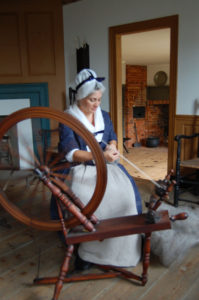By Rick Geffken |
HOLMDEL – Imagine for a moment that Garret Hendrickson, who died in 1801, reappeared inside his extant farmhouse in Holmdel. Hendrickson would feel, well, right at home, walking through the wood-framed house he bought from his cousin, William Holmes, in 1756. He’d recognize the Dutch floor plan with two large front rooms and smaller rooms in the rear of the house. Glancing into the separate kitchen wing, he’d look for the slaves who labored and lived there.
But once he stepped outside his brick-red painted home, Hendrickson would be quickly disoriented. How on earth did his house wind up here, just down the road from his Longstreet relatives? What did that Monmouth County Historical Association sign in his front yard mean? What was that huge dark structure over there in the middle of the fields he used to plow? Wasn’t that where his house should be?
What Hendrickson couldn’t know in this imaginary scenario is that the Monmouth County Historical Association (MCHA) has restored and cared for the Holmes-Hendrickson House since 1959, the year it was moved from its original location. After Bell Labs bought the old farm property 30 years earlier, the company needed room for a 2 million square-foot contemporary office building. Hendrickson’s 200-year-old house was moved to 62 Longstreet Road under the stewardship of the Freehold-based MCHA. After careful and expensive restoration, the MCHA opened it to the public in 1965.

Now, the MCHA is pursuing a “use and occupancy agreement” for the Holmes-Hendrickson House with the Monmouth County Park System. As Chuck Jones, interim director of the MCHA explained, “Our goal as an organization is to be ‘a shining light on the top of the hill’ when it comes to preserving Monmouth County history. As we continue our work on a transformational strategic plan this spring, it was easy to identify that deepened relationships with other strong organizations like our park system were good for MCHA and even better for a property like Holmes-Hendrickson.”
When the agreement is officially enacted, the Monmouth County Park System will provide ongoing maintenance and improvement to the property. Jones emphasizes that the MCHA will continue to run its educational programs and provide docents at the Holmdel landmark. For instance, the popular Wool Days celebration at the Holmes-Hendrickson House will take place this year from noon to 3 p.m. on April 29. Activities include spinning and weaving demonstrations, indigo dyeing and perusing the craft fair featuring a variety of local artisans. It will be free and open to the public.
“The acquisition process is moving along but not finalized and has to be officially approved,” said Gail L. Hunton, chief of the acquisition and design department of the Monmouth County Park System (MCPS). “MCPS purchased a conservation easement over the Holmes-Hendrickson House and property in 2011. We are pleased to be able to work with the historical association to permanently protect one of the most significant colonial Dutch houses in Monmouth County and New Jersey, and look forward to their continued program use at the historic site after it becomes a park system property.”
The Holmes-Hendrickson House was built by Garret Hendrickson’s first cousin William Holmes in 1754. The house combined elements of both Dutch and English 18th century architecture, befitting the heritage of the Hendrickson and Holmes families.
Among the first to settle in and around Holmdel, they were also believed to be among the largest slaveholders in Monmouth County, according to Colgate University’s Graham Russell Hodges, in the book “Slavery and Freedom in the Rural North.”
According to Hodges, Garrett Hendrickson himself signed a 1774 petition opposing the manumission, or freeing, of slaves.
He would needed them to work his vast acreage and to support his 12 children by three successive wives, Catharine, Helena and Nelly.
Garret Hendrickson and other Hendricksons are listed in the “Black Birth Book of Monmouth County 1804-1848” published a few years ago by the County Clerk, from research gleaned from county archives. In it, there are three slaves named Cuffy, Elizabeth and Harry, all children of their same mother Betty, and listed as owned by Garret D. Hendrickson.
George Beekman’s 1901 “Early Dutch Settlers of Monmouth County, New Jersey” notes that Hendrickson owned “some of the best farming lands in Monmouth County…well stocked with cattle, sheep, and swine.” He grew crops, raised sheep for wool and planted flax to produce linen. His prosperous farm and those of his neighbors were frequent targets of British raiders throughout the Revolutionary War. As a lieutenant in the Monmouth Militia, Garret Hendrickson participated in several skirmishes against the British during the Revolutionary War. He was wounded in 1780 and even held prisoner for a brief time two years later.
Hendrickson survived the war and returned to work his farm. His descendants lived in the house until 1873. For the next 50 years the house slowly deteriorated until Bell Labs bought the property and moved the farmhouse to its current setting.
MCHA’s Chuck Jones expects that the Holmes-Hendrickson house will officially become part of the surrounding Holmdel Park by the end of 2018. He sees it as a natural fit which might eventually include trail connections with Longstreet Farm and the other attractions in the verdant and popular public space.
This article was first published in the March 8-15, 2018 print edition of The Two River Times.














